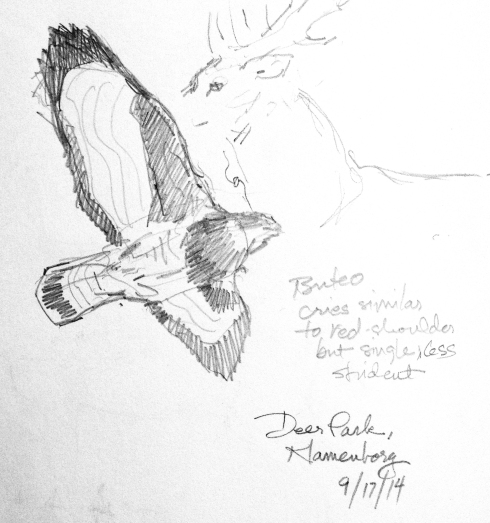
Getting out with Danish birders is delightful even if you don’t speak Danish. Birding is an international language, anyway; just watching and listening will get you pretty far. Many Danes speak quite a bit of English, too. When that fails, there’s always barking and pointing at the sky, but it really helps to learn a few terms and names to follow the action. You’ll want to write down the words phonetically, too, so get friendly with a Danish birder who’ll let you take notes. Then, when someone calls out, “Rød glente flyvende venstre”, which sounds like, “royl glinta floon ven-streh”, you can look up and see a red kite flying left.

The Danes are first-class birders. They move quietly and efficiently in the field. They know their birds. They are low-key and nearly single-minded; hunger does not slow the mission. They eat with binoculars held just north of the mouth.
And of course, I’m missing 15/16ths of the conversation- the buzz goes straight over my head like a flock of migrating lapwings (pronounced, vee-bay). I’m sure there were plenty of discussions on field marks and such, and I think there may have even been talk that wasn’t about birds at all, because nothing about birds could be that funny.
Actually, I take that back.

On a recent bus tour to southern Sweden with the Danish Ornithological Society, while we scoped out a marshy lake, my birder friend began telling me that the smew (which we didn’t see) is called a lille skallesluger, “the small one that swallows shells” and pochard, which we did see, is called a taffeland (the d is silent). He translated this roughly to “the snobbish meal duck”, so-called because, once upon a time, a Danish King handed them out as favors to his rich friends. Knortegås is the brent goose, and unless my friend is pulling my leg, “putgås”is its cute Swedish name. It means “farting goose”. I’m afraid I giggled.


I’m so immature.
At lunchtime, the group sat on an old concrete foundation by a stream, alternately eating bites and scanning the kites floating in circles overhead. Suddenly the trip leader hollered and I turned around in time to see a jackdaw-sized black bird flapping past a line of trees. It clearly held its head out front on a longish neck and wasn’t a jackdaw. It was a black woodpecker, one of my most-wanted birds. I turned back to the leader and gave him the thumbs-up sign and a silly grin.
I just hope thumbs-up means the same thing in Danish as it does in English.
Happy Friday.
Goofy! There is a flock or family of woodpeckers at the golf course I play at. They are so entertains to watch. And, they are not as critical about my swing as the deer herd of 5. Tough crowd, that bunch.
Sent from my phone
>
brilliant.
Love your sketches, stories, and your sharing of your ventures in Denmark!
Please tell me you have made the easy trek by train to Rungstedland to visit Isac Dineson/Karen Blixen’s (of Out of Africa fame) estate (with bird sanctuary to boot) and grave (of course!). I once flew to Copenhagen for the weekend with the express purpose of seeing her estate and to pay my respects. It was well worth it! Hopefully you’ll have time before you head back.
Rungstedlund, also known as the Karen Blixen Museum, is a country house in Rungsted on the Øresund coast just north of Copenhagen, Denmark, notable for its association with the author Karen Blixen, who lived there for most of her life. She was born on the estate in 1885, and returned there after her years in Kenya, chronicled in her book Out of Africa, to do most of her writings. The property is today managed by the Rungstedlund Foundation as an historic house museum. The property traces its history back to 1520 when it was owned by the Crown. The oldest part of the current house dates from about 1680 when it was a combined inn and agricultural estate. Notable guests who stayed at the inn include Ludvig Holberg and Johannes Ewald. Ewald lived there from 1773 to 1775 and wrote many of his poems, including The Delights Of Rungsted. An Ode. The locale also inspired him for The Hishermen, a singspiele remembered for Kong Christian stod ved højen mast, the Danish royal anthem.[1]
In 1879 the estate was purchased by Wilhelm Dinesen, father of Karen Blixen, and after his marriage to Ingeborg Westenholz in 1881 they took up residence there. Karen Blixen spent her childhood at Rungstedlund and took up residency there again after she returned from Africa in 1931. She lived there until her death in 1961 and did most of her writings in the Ewald Room. She is interred in the park. The park covers an area of 16.6 hectacres. Most of the grounds have been laid out as a bird sancturary. There are also flower gardens where every day during the summer season fresh flowers are cut for decorating the house.
Karen Blixen’s grave is located at the foot of Ewald’s Mound.
You’ve talked me into it, TR. I might get up there this week to pay tribute to the author of Out of Africa, one of my favorite books. A chilly walk in the bird sanctuary sounds fine, too. Thanks for the suggestion and the persuasive details!